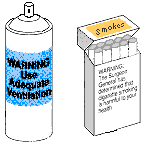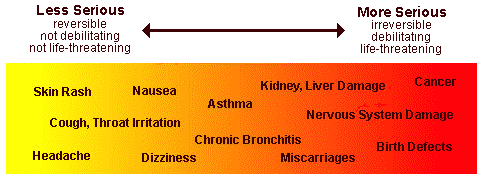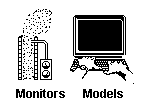Technology Transfer Network - Air Toxics Web Site
Air Pollution and Health Risk
Originally published as
EPA 450/3-90-022
March 1991
How Do We Learn About Risks?

 The warnings about risks from hazardous
substances are everywhere. Every day, the news media report information
on hazardous substances. Many products now tout warning labels or claims
about being "all natural" and "chemical free." How do we know when a risk
is serious? How do researchers estimate risk, and how does the government
use this information to develop regulations that limit our exposure to hazardous
substances? The following information should help you to answer these questions.
The warnings about risks from hazardous
substances are everywhere. Every day, the news media report information
on hazardous substances. Many products now tout warning labels or claims
about being "all natural" and "chemical free." How do we know when a risk
is serious? How do researchers estimate risk, and how does the government
use this information to develop regulations that limit our exposure to hazardous
substances? The following information should help you to answer these questions.Which Risks Are of Greatest Concern?

How Do Researchers Estimate Risk?
| Health Risk = Hazard x Exposure | ||
| Health risk is the probability, or chance,
that exposure to a hazardous substance will make you sick.

|
Animal experiments or human studies
provide information about how hazardous a substance is. Scientists
use the results of such studies to estimate the likelihood of illness
at different levels of exposure.

|
Information on exposure comes from two
places: (1) monitors placed on factory smokestacks or at special
places in your community, or (2) from mathematical models that estimate
exposure based on amounts of chemicals released.

|
Why Is Information Used for Health Risk Decision Making Uncertain?
Uncertainty About Hazard
 Many hazards are identified
by testing animals. We do not know for certain whether the hazard estimated
using animal studies is the same for humans.
Many hazards are identified
by testing animals. We do not know for certain whether the hazard estimated
using animal studies is the same for humans.
Information is uncertain because of:
- Lack of complete scientific understanding of how a hazardous substance makes you sick and how it moves through the air, water, or ground;
- too few human or animal studies of the health effects of individual chemicals and mixtures of chemicals;
- the variable nature of weather patterns affecting exposure;
- the inability to know everything
Uncertainty About Exposure
 We do not know for certain
that monitors or mathematical models always produce accurate estimates
of exposure. It is nearly impossible to account for the different exposures
a person may encounter daily.
We do not know for certain
that monitors or mathematical models always produce accurate estimates
of exposure. It is nearly impossible to account for the different exposures
a person may encounter daily.
What Are Important Factors in Risk Decision Making?
Balancing Scientific Results with Public and Economic Concerns
Ideally, regulators would like to eliminate all pollution and its risks, but this is usually not a realistic expectation. Regulators must address the most important risks and decrease them to the level at which they believe the risks are smaller than the benefits of the activity causing the pollution.
This is similar to what millions do each day when they balance the risks of an automobile accident with the convenience and necessity of driving. Just as a driver will buckle up and drive defensively to be safer, agencies take regulatory action to eliminate as much risk as is possible without losing the benefit.
Public Risk Perceptions
Scientific results may show that certain hazardous substances pose a low health risk to people, but the public may still be concerned about these hazardous substances because of different attributes of the risk. Other attributes may affect people's perceptions of a risk:
- How serious and dreaded is the illness?
- How certain is scientific knowledge?
- What is the catastrophic potential?
- Who bears the risk?
- Is the risk voluntary?
- Who receives the benefits of the "risky" activity?
Putting Risks in Perspective

What Do the Numbers Mean?
To provide an idea of the size of risks from environmental hazards as risk analysts will describe them to you, the continuum above presents risk statistics for some familiar events. Risk analysts describe risks numerically in scientific notation, for example 1 x 10[-5], which means that there is one chance in 100,000 of an event occurring. It is important to note that these risk statistics are population averages, while risk analysts usually estimate risk to the maximum exposed individual.
Actions to Reduce Risk
By becoming better informed you can reduce the risks that you determine to be unacceptable. This may mean changing your lifestyle or providing input to government, industry, and consumer / environmental interest groups. If you would like more information the sources listed below are a good place to start. You may also want to contact your local health department or regional or state environmental agencies for other information sources.
For More Information ...
Other Health Risk Publications
Risk Assessments for Toxic Air Pollutants: A Citizen's Guide
Evaluating Exposures to Toxic Air Pollutants: A Citizen's Guide
